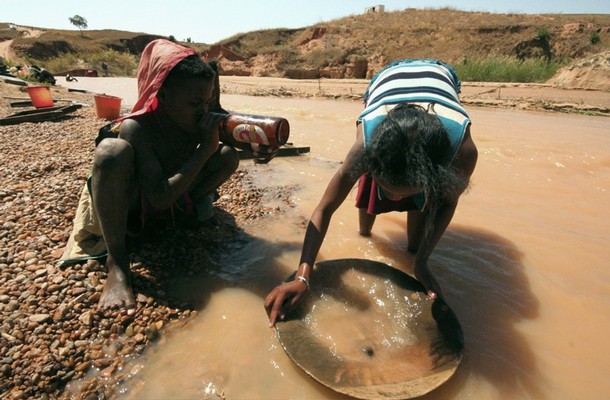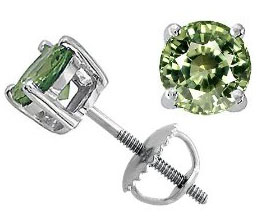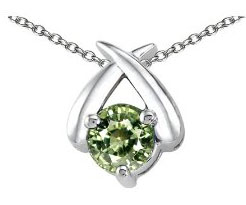Click here to see all our Green and Blue-Green Sapphire for sale
The green or blue-green hue comes from the presence of iron (FE) in the crystal. Because of the presence of the iron, the green or blue-green sapphire has a higher density than most other sapphires thus making the green or sapphire mineral the second most dense gemstone known to man. The green sapphire gemstone is also known as the stone of tranquility.
Green or blue-green sapphire gems are often faceted and cut in the round brilliant shape, but other fancy shapes are possible. There are square, pear, trillion, cabochon, round, emerald cut, oval, cushion, and heart shaped stones that are often available as well. At Sosnagems, you will find a large collection of fine quality cut green and blue-green sapphires
Sapphire and Burma Ruby are both corundum, sapphires are corundum of all colors except red. Red corundum is called ruby. Although pure corundum is colorless, sapphire is usually colored from a combination of titanium and iron oxides.
Sapphire is one of the most important of all the colored gemstones and comes in a wide variety of colors: blue, pink, yellow, green, purple, orange, padparadscha, blue green, lemon yellow, color change, and black color. With a hardness of 9 on the Moh's scale, sapphires are extremely hard and durable, and are suitable for use in any kind of jewelry.
Why Buy Loose Gemstones Instead of Pre-Set Jewelry?
There are many reasons, but basically it comes down to two factors, value and choice.
When buying your gemstone loose instead of a pre-set stone, you can be sure you are getting the best value for your money. Loose gemstones are less expensive, a better value, and you can really see what you are paying for. The most important part of getting the right price and finding the best value is to first see what you're getting. A jewelry setting will hide the inclusions inside a gem, and can deepen or brighten its color. With a loose stone you can much more easily inspect the gem and see it for what it really is. In this way you can get a better idea of its true worth and be sure you are paying a fair price.
The second advantage of buying a loose gemstone is choice. You are free to pick the exact color, cut, shape and variety of the stone for the setting of your dreams, be it yellow gold, white gold, platinum or silver; prong set or bezel set. You can experience the joy of creating your very own, one-of-a-kind jewelry design. Choose from a variety of jewelry settings and styles to create a completely original presentation that will perfectly suit your individual gemstone and will be as unique as you are!
| Origin | Madagascar, Thailand, Sri Lanka, Ceylon, Burma, Burmese, Australia, India, Kenya, Tanzania, U.S.A., China |
|---|---|
| Color | Light to dark green, blue green, loose sapphire in all shades of green or blue-green. |
| Refractive Index | 1.759-1.778 |
| Chemical Composition | AL2 O3 |
| Hardness | 9 |
| Density | 4 |
| Crystal Structure | Trigonal |
| Zodiac Sign | Libra |
| Planet | Venus |
| Month | September |
| Anniversary | 5th and 45th |
Green sapphire's mellow and relaxing colors are just one reason for this gemstone's popularity. As with all sapphire, it's also extremely durable, having a hardness of 9 on the Mohs scale. Sapphire has a specific gravity of 4.00, a refractive index of 1.76 - 1.78, and birefringence of 0.008. The refractive index (RI), measured using a refractometer, is an indication of the amount light rays are bent by a mineral. Birefringence is the difference between the minimum and maximum RI. When birefringence is high, light rays reflect off different parts of the back of a stone causing an apparent doubling of the back facets when viewed through the front facet.
Most gems have a crystalline structure. Crystals have planes of symmetry and are divided into seven symmetry systems. The number of axes, their length, and their angle to each other determine the system to which a crystal belongs. The gems green and blue-green sapphire are classified as having a trigonal crystalline structure because they have three planes of symmetry and four axes. Three axes are at 60 degrees to each other in the same plane. The fourth axis is perpendicular and unequal in length to the other three. The form of a sapphire's crystals depends on the variety and locality. Sapphires may have an uneven or a conchoidal fracture but no real cleavage. The amount of light reflected at the surface of a gemstone is its luster and blue sapphires have a glassy (vitreous) luster as opposed to the waxy, greasy, or resinous luster of other stones.
Color is the single most important factor in determining the value of a green or blue-green sapphire. Indeed, the color of a sapphire is more important than its clarity. Sapphires are rarely clean and even very expensive stones can be slightly included. Subtle differences in color can make great variations in valuations of fine gemstones. Fine loose gemstones of good color and clarity are always rare and valuable. Highly saturated medium or medium dark green and blue-green tones are best, green and blue-green sapphires which are too dark or too light are worth considerably less.
The name sapphire comes from the Greek word "sapphirus", meaning "blue". However, sapphire gemstones come in many colors including pink, yellow, orange, green, black, color-change, purple, violet, light blue, and the rare orange-pink Padparadscha sapphire gems. Padparadscha comes from the Sinahalese word meaning "lotus color". Sapphires other than blue, pink, yellow, green and orange sapphire are usually called "natural fancy-color sapphire". Red hues result from traces of chromium. The greater the concentration of oxides the deeper the color.
Ovals,rounds, cushions and emeralds are the most common cuts for sapphire, due to the typical shape of sapphire rough. Other popular sapphire shapes include pears, briolettes, hearts and marquises; Star sapphires are cut into the cabochon shape in order to develop and properly display the star effect. Fibers or fibrous cavities within a star sapphire reflect the light which causes a star to appear within the stone. A six-ray star sapphire has three sets of parallel fibers. Skilled cutters can sometimes create a 12-ray star sapphire but they are rare.
The traditional heating of ruby and sapphire is a widely used and is an accepted enhancement process which can improve the transparency and color of the stones. Techniques range from simply throwing gems into a fire to be cooked, to employing sophisticated electric or gas furnaces at specific pressures and atmospheric conditions. The treatment is permanent and heated stones do not require any special care.
New treatments which are used to produce blue, pink, orange and yellow sapphire stones are more controversial. This new treatment is a heat-diffusion process which is stable and may or may not completely penetrate the stone. The color is achieved through a process which includes the addition of foreign elements to achieve the desired color alteration. We at Sosnagems will always disclose this treatment.
Sosnagems fully discloses any and all treatments to our gemstones.
For decades, the basaltic lava rocks and river sands and gravels of Burma, Thailand, Sri Lanka, Ceylon, Pailin Cambodia have been major sources of excellent quality gem sapphires. Other sources of loose sapphire are Australia, Brazil, Kashmir, Kenya, Malawi, Tanzania, Zimbabwe and Montana, USA.
Today however, there is a new and important source of gem quality sapphires on the market - Madagascar. Its blue sapphire's are similar in appearance, quality, and material to those from Sri Lanka. Generally they are indistinguishable from Ceylon sapphires and are interchangeable in value.
Madagascar


In the early 1990's, a new source of gem quality sapphire stunned the international gemstone market. Madagascar, a large island nation off the south-east coast of the African continent, became the hottest news in the precious gem industry. With just a few years of development, several new mine sources began producing commercial to top gem quality sapphires the likes of which had not been seen for over a century.
Buyers from around the globe flocked to the new finds. Once small villages of a few dozen mud huts soon became wild west boomtowns with 10's of thousands of new inhabitants. Most of the newcomers were itinerant miners looking to strike it rich in the pay dirt of the Madagascar wilderness. Dirt poor farmers could become instantly wealthy by local standards with the find of just one exceptional rough sapphire crystal.
These new African deposits have been a boon to sapphire traders everywhere in the world. There is now a whole new range of beautiful blue gemstones available to gem dealers, jewelers and collectors, many of which are often compared with Ceylon sapphire. The color saturation, clarity, evenness and purity of color occasionally rival the finest of Burma and even the elusive sapphires of Kashmir.
Production from Kashmir has been virtually nothing for the past several decades, making fine sapphires from this source nearly impossible to find. Burma however, does continue to produce excellent quality sapphires to this day, but in very small quantities.
The wonderful advantage to modern day sapphire lovers is the relative availability of Madagascar gems at affordable prices. Madagascar has made the dream of owning a Kashmir look-alike possible to a wide range of gem lovers around the world.
Ilakaka and Sakaraha are situated a little south of the island Madagascar near a place called Toliara or Tulear. Since its discovery in 1998, the mine has seen active mining and trading from all over Madagascar is conducted here. Go past the desert southwards and you will reach a place called Andranondambo. Known at one time as Fort Dauphin, Tolanaro is a metasomatic sapphire mining area for blue sapphires where, in 1994 the first sapphires of gem quality were found.
Sri Lanka

Mining on the island of Sri Lanka goes back at least 2000 years. This island has its own heritage in the mining arena. The island is called Gem Island or "Ratna Dweepa" because of the large variety of gems found here. You will find everything from peridot to moonstones to garnets and topaz. Today Sri Lanka is best recognized for it's the sapphires called the Ceylon Blue, and the sapphire called Padparadscha which has a beautiful and unique orange pink pastel soft color, very similar to the Lotus flower found on this island. The traditional Ceylon mines are near Ratnapura which is located southeast of Colombo about 100kms away.
Sri Lanka is still one of the world’s largest sources of fine quality blue sapphire. It is a place where one can regularly find excellent gems over the 100 carat mark. Many of the famous large sapphires in museums around the world came from this gemstone rich tropical island. Sri Lanka is also a very well known source for fine quality star sapphires.
Rubies can be found in the U.S. in the Cowee Creek District, Macon Co., North Carolina. A few scattered finds were reported in Sparta and Ogdensburg, Sussex Co., New Jersey.
The production of gem-quality sapphires in the United States is not new or recent. In 1865, the first U.S. sapphires were found in the gravels of the Missouri River in Lewis and Clark County, Montana. This was followed by subsequent discoveries on Dry Cottonwood Creek in Deer Lodge County in 1889, on Rock Creek in Granite County in 1892, and in Yogo Gulch in Judith Basin County in 1895. Additionally, small amounts of sapphire are recovered from Quartz Gulch in Granite County, Pole Creek in Madison County, the Missouri River in Chouteau County, and Brown's Gulch in Silver Bow County. Furthermore, corundum crystals, from which star sapphires have been cut, are found in Beaverhead and Madison Counties. Also, in 1895, the first sapphires were produced from the Cowee Valley in Macon County, North Carolina. But until very recently, with the exception of Yogo Gulch material, the commercial gemstone industry has had limited interest in U.S. saphires.
Montana.--Mining of Yogo Gulch sapphires began within a year of their discovery in 1895 and continued for 39 years. In 1923, the mine was damaged so badly by rain that it could not economically recover. Other attempts have been made to commercially mine the deposit, but to date, all of these attempts have ended in economic failure.
Yogo's are unique among the world's sapphires. They lack the color zoning so prevalent in other sapphires, their uniform "corn-flower blue" color is natural (not the result of heat-treating), and their clarity is uniformly high. These features rank them among the world's finest sapphires. Unfortunately, the rough is both small and flat, wafer-like in shape. The majority of the crystals or pieces of crystals recovered are too small to be cut, most are less than 1 carat and finds of over 2 carats are rare. Reportedly, the largest crystal was a 19 carat stone found in 1910 that was cut into an 8-carat stone. The size of the cut stones greatly restrict the market for Yogo's, they are beautiful, small, very expensive sapphires.
Currently, Yogo sapphires are produced from three sources: Rancor lnc., produces material from the original Yogo Gulch deposit; Vortex Mining produces from a recently discovered extension of the Yogo dike; and material is produced by individuals from privately owned lots in Sapphire Village. The first two producers market only cut stones and finished goods and the third is comprised essentially of hobbyists.
Historically, the amount of sapphires produced from the Missouri River and Rock Creek areas greatly exceeded that from Yogo Gulch. However, the value of the material produced from Yogo, reported to be in excess of $30 million, is significantly greater than that of the combined values of the other areas. This relationship is rapidly changing.
The combination of large volume commercial operations on the Missouri River, and to some extent Rock Creek, plus the advent of successful heat-treating techniques for the material has greatly enhanced the acceptance of these sapphires by the gemstone industry. This enhanced acceptance has resulted in a significant increase in the market for and value of U.S. sapphires. Unconfirmed reports have circulated that a parcel of select 3- to 10-carat material, suitable for heat-treating, was sold for as much as $40,000 per kilogram. A more realistic price for 3- to 10-carat, sorted mine-run material is in the range of $5,000 per kilogram, with many kilograms of mine-run rough selling for $1,000 per kilogram.
The sapphires from the Missouri River gravels in Lewis and Clark County are a mixture of rough and pitted crystals showing well defined faces and completely rounded and smooth-surface highly stream worn pebbles. The majority of the material is pale blue or blue-green, with deep blue stones quite rare. Stones also are found in pastel blue, green, pink, pale red, purple, yellow, and orange. Most of the stones recovered are less than 6.4 millimeters in diameter, but material 6.4 to 12.7 millimeters in diameter are not uncommon. Material greater than 12.7 millimeters in diameter is rare.
Currently there are seven operations on the Missouri River that commercially produce sapphires and/or operate a dig-for-fee area. Not all of these may be active in any one year. It is the author's understanding that one operation, currently inactive, (a self-propelled floating 16-inch suction dredge) is for sale. The mines operate from about the last week of May through the first week of September.
The Rock Creek sapphires are very similar to the sapphires from the Missouri River but differ in the general shape of the crystals. The stones are basically crude hexagonal plates about the same dimension in width and height, with a much higher percentage of the material being well rounded water worn pebbles. There appears to be more of the larger sized (greater than 12.7 millimeters) material. Additionally, it is reported that the Rock Creek material has a greater percentage of stones that can be heat-treated for color enhancement.
During the past several years, there has been only a single producer on Rock Creek. The producer operated both a commercial recovery plant and a fee recovery area. The fee recovery area sold buckets of gravel for washing and also offered, for a predetermined fixed fee, the output of one day's operation of the commercial wash plant. There is work underway which would result in a second, much larger producer, opening an operation on another deposit in the area. If things go as planned, the new operation on Rock Creek would be the largest sapphire producer in Montana.
There are a number of locations between Dillon in Beaverhead County and Ennis in Madison County that produce lavender, grayish-lavender, bluish-gray, and gray hexagonal sapphire crystals that, when cut, produce stones that contain four- or six-ray stars. At least one producer from the Dillon area is currently advertising the availability of this type of material. The remainder of the sapphire deposits in Montana appear to be operated by individual hobbyists.
Every year articles appear in magazines and newspapers about large and valuable sapphires found at one or more of the mines in Cowee Valley. No doubt large corundum crystals and pieces of corundum are found each year. By the same token, valuable sapphires may be found, but the number of large valuable gemstones are far less than reported, and the values are generally not as great as reported. During the period when the area was commercially mined, gem material was found that would cut fine quality 3- to 4-carat stones, but the amount of quality gem material available has greatly declined. It is doubtful that North Carolina will ever again boast of commercial sapphire production, or that the commercial gemstone industry will seriously consider the State's saphire deposits.
Legend has it that the first person to wear Sapphire was Prometheus, the rival of Zeus, who took the gemstone from Cacaus, where he also stole fire from heaven for man.
Known as the "Gem of Heaven", the ancient Persians believed Sapphires were a chip from the pedestal that supported the earth, and that its reflections gave the sky its colors.
Tradition holds that Moses was given the Ten Commandments on tablets of sapphire, making it the most sacred gemstone. Because blue sapphires represent divine favor, they were the gemstone of choice for kings and high priests. The British Crown Jewels are full of large blue sapphires, the symbol of pure and wise rulers.
The guardians of innocence, Sapphires symbolize truth, sincerity and faithfulness, and are thought to bring peace, joy and wisdom to their owners. In ancient times it was believed that when the wearer of a Sapphire faced challenging obstacles, the gem's power enabled them to find the correct solution.
In India it was believed that a Sapphire immersed in water formed an elixir that could cure the bite of scorpions and snakes. Alternatively, if it were worn as a talisman pendant, it would protect the wearer against evil spirits.
The following legend is Burmese in origin and highlights Sapphires‘ connection with faithfulness: “Eons ago Tsun-Kyan-Kse, a golden haired goddess with Sapphire blue eyes, presided lovingly over the temple of Lao-Tsun. Everyday, the temple‘s chief monk Mun-Ha, meditated before the golden goddess accompanied by his devoted companion, a green-eyed cat named Sinh. One day the temple was besieged by a group of terrible outlaws. When they threw Mun-Ha to the floor, Sinh leapt fiercely at the bandits, jumping up on his master‘s chest to protect him. The wrong doers fled screaming in fear, never to return and in gratitude for his courage, the golden goddess awarded Sinh with her Sapphire blue eyes. To this day, Sinh‘s ancestors guard over the temple.” The temple still stands and is populated by Siamese cat‘s with striking blue eyes (typically this breed has green eyes).
For hundreds of years Blue Sapphires were the popular choice for engagement and wedding rings.



